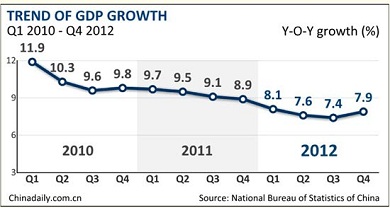A few months ago, the Communist Party announced the beginning of a new trend where growth of at least 8% would cease to be on the spot. The years of rampant expansion, when GDP grew over 10% were therefore gone. A dramatic fall on exports forced the Communist Party to make a stop on the way, take a deep breath and think about how to get the Chinese to embrace spending. Accordingly, they put on force incentives for consumption as well as infrastructure investment. Likewise, they set a modest growth goal of 7.5% for 2012 in an attempt to weather the storm and keep the economy out of a hard-landing.
The top priority this year is to maintain sustained and steady growth while the country embraces much needed reforms. The current economic model is not able to provide alternatives to the majority of the population. Without a safety net guaranteeing social and health services as well as equal access to education, the Chinese rely solely in themselves; and most importantly, their savings.
So, the fact that last year’s GDP was the lowest in thirteen years is good or bad news for the world and the Chinese economy? The opinions were mixed. The authorities were happy to point out that last quarter’s rebound was a sign that the economy is picking up pace and in the good track to avoid a hard-landing. A relief for those fearing a global recession due to China’s sharp slowdown. Conversely, other readings point out that there is a serious risk of stagnation. Stabilization must be sustainable in the long term, which means it must lead to structural reforms. Should the regime’s vows to reform not be meaningful, the economy would encounter a very serious situation. Inflation and soaring house prices coupled with a widening wealth gap make consumption just a privilege of the few.
In such scenario, some experts prefer to be cautious with regard to growth figures. The same day that GDP data was released, the National Bureau of Statistcs presented another worrying and relevant data. Last year also saw an absolute decrease of the labour force. Now China counts with 3.4 million potential employees less. A number that is expected to continue falling as the country sees how the consequences of years of rampant growth are finally coming to light.






Be the first to comment on "China’s growth: the glass half full or half empty?"